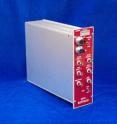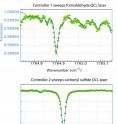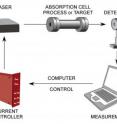Precise trace gas analysis, without the noise
Analyzing trace atmospheric gases can now be considerably more precise with the help of a device that delivers stable and reliable power to the lasers used in gas sensors. The low-noise current controller was developed at the Department of Energy's Pacific Northwest National Laboratory. The technology was recently licensed to Bozeman, Montana-based Wavelength Electronics Inc. by Battelle, which operates PNNL for DOE.
"Low-noise current controllers open up new ways for us to analyze trace gases," said Matthew Taubman, a PNNL scientist who developed the device. "Now we can evaluate significantly smaller gas concentrations."
Scientists often analyze atmospheric gas concentrations with laser-based sensors. Researchers sample air at sites of interest, such as on the ground near power plants or at high altitudes from airplanes. The sensor instrument then directs a laser through the sample. Based on how much laser light is absorbed by the sample, scientists can determine the specific gases present and their concentrations.
But smaller concentrations of certain gases can be challenging to analyze. One particular problem occurs when "noises," or random fluctuations, exist in a laser's wavelength and line width. Such noise prevents researchers from making precise readings.
PNNL scientists reduced this problem by developing a low-noise current controller. The device reduces the noise on the laser's power source, allowing scientists to detect smaller levels of trace gases. PNNL's controller is the lowest noise controller on the market that was specifically designed for extra-sensitive sensors that use quantum cascade lasers, also called QCLs. Sensors made with QCLs emit light in a wavelength region that many trace gases strongly absorb. QCL-based sensors become even more sensitive when they are powered with low-noise current controllers like PNNL's.
Wavelength Electronics already develops compact current controllers and related components for a variety of semiconductor lasers. Wavelength CEO Mary Johnson also recognized there was a strong potential for her company to make similar QCL-friendly components for Wavelength's customers - original equipment manufacturers, or OEMs.
That prompted Wavelength to request support through PNNL's Technology Assistance Program, which pairs small businesses looking to overcome specific technology challenges with PNNL scientists. Through the program, Taubman - the researcher who developed PNNL's low-noise current controller - compared Wavelength controllers to PNNL low-noise controllers.
At the same time, PNNL and Wavelength brought PNNL's low-noise controllers to one of Wavelength's customers, sensor systems manufacturer Aerodyne Research Inc. of Billerica, Massachusetts. Aerodyne tested the low-noise controllers and learned the devices provided the sensitivity their QCL-based sensors needed. This convinced Johnson that licensing PNNL's controllers would speed up Wavelength's entry into the QCL-based sensor market.
"There's a tremendous need for this technology right now and Wavelength Electronics is pleased to be able to offer it to trace gas researchers and analytical instrument manufacturers," Johnson said.
Wavelength is looking to launch products that incorporate PNNL's low-noise current controller technology by the end of this year. The products will specifically target the QCL market. But other models will be available to work with laser diodes that could be used in microbial detection, skin cancer scanning, DNA sequencing, remote measurements and testing with VCSELs, or vertical cavity surface-emitting lasers, a kind of laser diode.
But Aerodyne didn't want to wait until Wavelength released its new products. Soon after the license went through, Wavelength made the sensor system manufacturer a copy of the low-noise controller for immediate use. Aerodyne is now using these controllers with their most demanding sensor applications, those with continuous-wave QCLs.
Source: DOE/Pacific Northwest National Laboratory
Other sources
- Precise trace gas analysis, without the noisefrom Science BlogMon, 24 May 2010, 18:20:30 UTC
- Precise trace gas analysis, without the noisefrom PhysorgMon, 24 May 2010, 17:50:36 UTC


